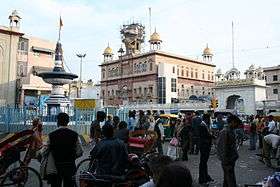Gurudwara Sis Ganj Sahib



Gurdwara Sis Ganj Sahib, is one of the nine historical gurdwaras in Delhi. First established in 1783 by Baghel Singh to commemorate the martyrdom site the ninth Sikh Guru, Guru Tegh Bahadur. Situated in Chandni Chowk in Old Delhi, it marks the site where the ninth Sikh Guru was beheaded on the orders of the Mughal emperor Aurangzeb on 11 November 1675 for refusing to convert to Islam.[1][2]
History
The ninth Sikh Guru, Guru Tegh Bahadur was beheaded here on 11 November 1675 on the order of Aurangzeb. Before his body could be quartered and exposed to public view, it was stolen under the cover of darkness by one of his disciples, Lakhi Shah Vanjara, who then burnt his house to cremate the Guru's body. This place is marked by another gurdwara, Gurdwara Rakab Ganj Sahib.
The severed head ("Sis" in Hindi or Punjabi) of Guru Tegh Bahadur was brought to Anandpur Sahib by Bhai Jaita, another disciple of the Guru. Before it was cremated, he took it to Ambala city for a night and there is another gurudwara as well by the name of Shri Sis Ganj Gurdwara near there local vegatable market, Gobind Rai, who would later become Guru Gobind Singh, the tenth and last Guru of the Sikhs.[2][3]
Gurudwara


The present gurudwara structure was built in 1930. The trunk of tree under which the Guru was beheaded is also preserved here as is the well from which he took bath while in the prison. Also standing adjoining the gurudwara is the Kotwali (police station), where Guru was imprisoned and his disciples were tortured.
On 11 March 1783, Sikh military leader Baghel Singh (1730–1802) marched into Delhi along with his army. He occupied the Diwan-i-Am, the Mughal emperor Shah Alam II made a settlement with them agreeing to allow Baghel Singh to raise gurudwaras on Sikh historical sites in the city and receive six annas in a rupee (37.5%) of all the octroi duties in the capital. Sis Ganj was one of shrines built by him, within the space of eight months, from April to November 1783. However, due to volatile political climate in the coming century, the site alternated between being a mosque and a gurudwara. The sit became a site for dispute between two communities and litigation followed. Eventually after prolonged ligation the Privy Council during British Raj ruled in the favour of the Sikh litigants and the present structure was added in 1930, gold guild of the domes was added in the coming years. The Kotwali was handed over to the Delhi Sikh Gurdwara Management Committee around 2000.[2][3][4]
Another gurudwara by the same name, Gurudwara Sisganj Sahib at Anandpur Sahib in Punjab, marks the site were in November of 1675, the head of the martyred Guru Teg Bahadur, brought by Bhai Jaita (renamed Bhai Jivan Singh according to Sikh rites) in defiance of the Mughal authorities was cremated here.
Located close to it is the Sunehri Masjid (Chandni Chowk).
References
- ↑ Gurbachan Singh Talib (Ed.) (1976). Guru Tegh Bahadur: background and the supreme sacrifice. Punjabi University.
- 1 2 3 H. S Singha (2000). The encyclopedia of Sikhism. Hemkunt Press. p. 187. ISBN 81-7010-301-0.
- 1 2 H.S. Singha (2005). Sikh Studies, Book 7. Hemkunt Press. p. 43. ISBN 81-7010-245-6.
- ↑ Mohindar Pal Kohli (1992). Guru Tegh Bahadur: testimony of conscience. Sahitya Akademi. p. 36. ISBN 81-7201-234-9.
External links
| Wikimedia Commons has media related to Gurudwara Sis Ganj Sahib. |
Coordinates: 28°39′21″N 77°13′57″E / 28.6558°N 77.2325°E